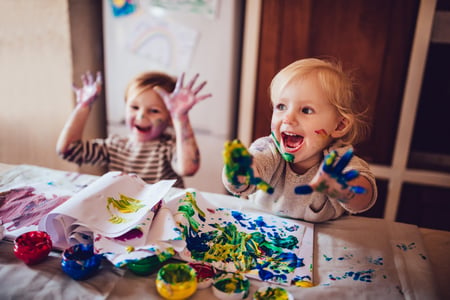
Most kids like arts and crafts. They’re a great outlet for creativity. Ever watch a child finger-paint and see their delight as they make huge swirls and marks with their paint covered hands? Because arts and crafts are fun, they are a go-to activity for teachers, baby-sitters, and parents alike.
At this point, you may be asking yourself if your children are getting bored of doing arts and crafts. Or you may be worried that they aren’t “keeping up” with their learning. In this blog post, I’ll share some ideas of how you can embed learning into arts and crafts. Young children learn through play and arts and crafts are an important part of their learning.
Some of the most common materials for arts and crafts activities for young children include: paper, colored pencils, crayons, markers, scissors, glue, glitter, pom-poms, googly-eyes, and magazines. Additional fun items include bottle caps, cork, sequins, ribbon, crepe paper, and stickers. Most kids can find all sorts of things to do with these items. If you’re running low on supplies, there are all sorts of arts and crafts activities that you can do with things you already have in the house. I’ll share those ideas at the end.
Think about what you can do with...
Paint
Ask your child to “tell you about their picture.” It’s a great open-ended question that invites more complex language from a child. Younger children can identify colors, while older children can learn how to mix colors to make new ones. As they make lines across and up and down the paper, introduce the words vertical and horizontal and explain what those words mean. If they first use a skinny brush and then pick up a fat brush, you can talk about concepts such as narrow and wide. And remember the finger painting example above? In addition to making shapes and letters, children are refining their fine motor skills.
Paper and Scissors
Cutting with scissors is a skill that requires fine-motor skills, eye-hand coordination, and attention. Children don’t just pick up a pair of scissors and begin to cut out shapes. First they learn to snip, then they learn to snip along a line, graduating over time to cutting straight and then curved lines. First the lines will be wide and over time they’ll become narrower. Initially, you may wish to have your child tear paper to build up the muscles in their hands. Folding paper is another task that builds fine-motor skills and eye-hand coordination.
Magazines, Paper, and Glue
These three words make me think about collages, which promote eye-hand coordination, vocabulary, cause and effect, and the development of new concepts (e.g., “You put the picture of the girl next to the house.”) Younger children will need an adult’s assistance to cut the pictures out, spread the glue, and hold the paper in place for them. Talk with your child while they create. “What are you putting on your collage?”” Why did you pick that item?”Introduce the words glue and sticky. As the children put things on their paper, narrate their actions (e.g., “I see you put a square at the top of the paper. That square is turquoise.”) School aged kids can have fun going through magazines to search for pictures that match a theme or look for different letters or words that they want to include.
Running low on supplies? Look around your house. Clean kitchen sponges may cut into shapes for painting, while q-tips make good paint brushes. Those envelopes, old stationery, and stickers that you have in your desk may be used for writing and drawing projects. And while you may not want to deplete your food supply right now, pasta, dry cereals, and dried beans can be used for a variety of things such as making necklaces (ziti or tube pasta) or glueing onto pictures.
Other Arts and Crafts Resources
- Collage Art and Your Toddler's Fine Motor Skills By Stephanie Brown
- Crafts for Toddlers - Arts and Crafts for Toddlers
- Developmental Progression of Scissor Skills: 35 Best Tips for Teaching Kids to Use Scissors!
- Ideas and Fun Facebook Group
- Loose Parts Play - Home
- 50+ Quick & Easy Kids Crafts that ANYONE Can Make!
Art can be used to help children regulate and work through big emotions! Learn more about how educators can use arts and crafts time to help children find emotional safety in this episode of Teaching with CLASS!
